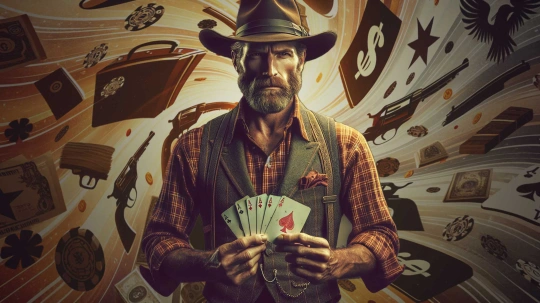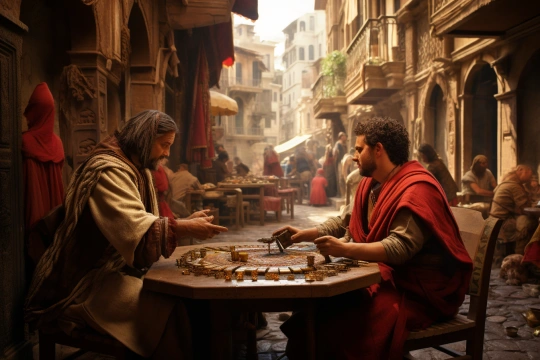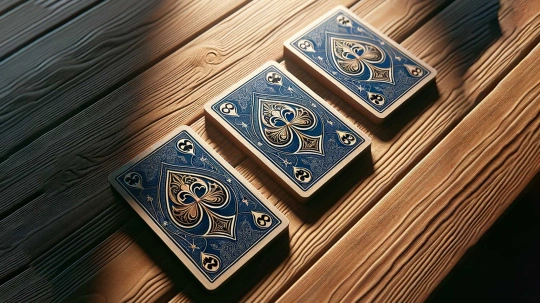Faro is a card game that has left an indelible mark in the history of gambling. Its European roots, popularity among gold miners in America, and the uniqueness of its rules and strategies make Faro extremely interesting.
This game, once called the queen of the casino and a favorite of gold miners, often remains in the shadows today. However, the historical significance of Faro, its influence on casino culture, not to mention the originality of the gameplay, deserve our attention.
Let's start exploring, immersing ourselves in the world of Faro, a game that once captured the hearts of many people around the world.
History of Faro
Faro was one of the most popular gambling games of the 18th and 19th centuries, especially in the United States. However, its roots go even further back in history and lead us to Europe.
Origin in Europe
The game, originally known as "Pharaon" or "Faro," appeared in France in the late 17th century. The name "Pharaon" translates as "Pharaoh," and although the exact reason for such a name is still debated, it is believed to have been inspired by images of pharaohs on cards.
Spreading in America
Arriving in North America with the first settlers, Faro quickly became popular, especially during the "Gold Rush." Gold miners, seeking entertainment after a hard day's work, often gathered at tables to play Faro. The fast pace of the game and the simplicity of the rules made Faro an ideal game for those who sought quick gambling.
Rules of Faro
Faro is a card game that is played with a full deck of 52 cards. The goal of the game is to bet on the card that will be drawn from the deck by the dealer. Here are more detailed rules of the game:
Beginning of the game
Placing bets: Players place their bets by placing chips on the corresponding cards on the game board - "Faro board". Any card can be bet on, and multiple bets can be made on different cards.
Dealing cards: The dealer (or "banker") shuffles the deck and draws two cards. The first card drawn is the "losing" card, the second is the "winning" card. The cards are revealed and placed in a special place on the table, known as the "safe".
Course of the game
Determining results: If a player's bet was made on the "winning" card, they win the bet. If the bet was made on the "losing" card, the player loses their bet. If the bet was made on any other card, it remains in place until the next round.
Continuing the game: The process repeats with a new round of bets and card dealing until all cards in the deck have been used. After that, the deck is shuffled, and the game starts anew
Special situations
Split: If the "winning" and "losing" cards have the same rank (for example, two tens), this is called a "split". In this case, the dealer takes half of the bet of each player who bet on this card.
Case-card: If there is only one card of a certain rank left in the deck, it becomes a "case-card". Players can make special bets on the "case-card", and if it turns out to be the winning one, they get a double win.
These are the basic rules of Faro. As you can see, despite its simplicity, this game offers many opportunities for an interesting and exciting game.
Strategies in Faro
Faro, despite its simplicity, offers players a plethora of opportunities for developing and applying various strategies.
Betting on High and Low Cards
One of the primary strategies in Faro is betting on high or low cards. Given that the deck contains an equal number of high and low cards, this may seem an attractive option for wagers. However, it's important to remember that Faro is a zero-sum game, and in the long run, you'll win and lose an equal number of times.
Betting on "Splits"
A "split" occurs when the "winning" and "losing" cards have the same rank. In this case, the dealer takes half the bet of each player who wagered on that card. Some players employ a strategy of betting on cards that have already been "split," hoping they won't be "split" again. However, this is a risky strategy, as the likelihood of a "split" for each card is equal.
Betting on the "Case Card"
The "case card" is the last card of a certain rank in the deck. When it appears, players can make a special bet on this card, and if it wins, they receive double the payout. This can be an effective strategy for increasing potential winnings, but keep in mind that it also increases the risk of loss.
Bankroll Management
One of the most important aspects of any card game strategy is bankroll management. In Faro, this is especially important, as the game has a zero-sum edge. You need to decide in advance how much you're willing to spend and strictly stick to that limit to avoid significant losses.
Even though Faro is a game based on luck, employing an effective strategy can help you maximize your winnings and minimize losses. Remember, the most important element of any strategy is patience and the ability to maintain your composure in even the most intense situations.
Big Wins in Faro History
Faro attracted players with the chance of a quick and substantial win, and there have been many remarkable examples of successful games in the history of this game. Below are two of the most famous instances.
Doc Holliday
Perhaps the most famous Faro player in history is Doc Holliday, the infamous doctor, gambler, and gunslinger of the Wild West. Holliday was a skilled Faro player and often used the game as a means of income.
One of his most notable wins was in Dodge City in 1878. Holliday came to town to partake in the game, and over a few days, managed to win over $8,000. This win drew significant attention to the game and increased the popularity of Faro in the Wild West.
"Diamond Jim" Brady
Another famous Faro player was "Diamond Jim" Brady, known for his massive bets and wins. Brady was known for his extravagant diamond adornments and big-spender lifestyle, and his Faro bets were a fitting addition to his image.
Once, while playing Faro in a New York casino, Diamond Jim placed a $10,000 bet on a single card - and won. This win was one of the largest in the history of the game and made Diamond Jim famous among gambling circles.
Bob Ford
Bob Ford, known in Wild West history as the man who killed Jesse James, was also an active Faro player. In 1882, in Cripple Creek, Colorado, Ford won an astonishing $6,000 in one night. This win allowed him to open his own casino and continue his career in the gambling world.
Wyatt Earp
Wyatt Earp, the famous lawman and hero of the Wild West, was also a participant in Faro. Unlike many others, Earp preferred to be the dealer rather than the player. However, in 1875 in Wichita, Kansas, he made an exception and played Faro, winning $3,000. This win significantly bolstered his financial status and contributed significantly to his reputation.
Sam Bass
Sam Bass, a notorious thief and bandit from the Wild West, is also known for his Faro wins. After successfully robbing the Union Pacific train in 1877, Bass arrived in Texas, where he spent much of his loot playing Faro. He won substantial sums, but ultimately lost most of his winnings, leading to his unfortunate end.
These historical Faro wins highlight not just the excitement and risk of the game, but also its place in American culture and history.
Fun Facts About Faro
First Gambling House in Vegas
The first permanent gambling house in Las Vegas, The Golden Gate, was opened in 1906, and one of the initial games offered there was Faro. This helped establish Faro as one of the most popular games in early Las Vegas time.
Single Deck Game
Unlike many other card games, Faro is typically played with a single deck. This makes the game more predictable and allows players to use strategies based on probability and statistics, rather than sheer luck.
The Royal Card
In traditional Faro, the "royal card" (usually queen) was considered the most valuable. Players who managed to bet on this card and win could garner substantial winnings.
First Slot Machines
The first slot machines, invented in the late 19th century, were based on the rules of Faro. These machines, known as "poker machines," were based on the same concept of random card selection as in Faro and became the basis for modern slot machines.
Legislation Against Faro
Many parts of the U.S. passed laws specifically targeting Faro. This was particularly prevalent in the late 19th and early 20th centuries when the game became associated with crime and corruption. Some of these laws remain in force today, although Faro has long since fallen out of fashion.
Faro Today
Today, Faro is a relatively unknown game, overshadowed by more popular gambling games such as poker and blackjack. However, it continues to draw the interest of historians and card game enthusiasts for its unique place in the history of the American Wild West.
In select locations and casinos across North America and Europe, Faro is still being played, though this is more the exception rather than the rule. The game is also available online on some platforms, where it is presented in virtual or live versions.
Faro also continues to appear in pop culture, particularly in westerns and other works based on the theme of the Wild West.
"Tombstone" (1993): In this film, based on actual events in the town of Tombstone, Arizona, in the late 1800s, Doc Holliday, a character played by Val Kilmer, is a professional Faro player.
"Dead Man" (1995): In this Jim Jarmusch film, the main character plays Faro in a saloon. This becomes a key point in the story.
"Deadwood" (2004–2006): In this popular HBO television series, Faro games often feature in the plot, particularly in scenes set in the gambling house.
"Red Dead Redemption 2" (2018): In this popular video game set in the Wild West era, players can play Faro, along with other card games.
Conclusion
Faro is a unique game that has left a significant mark on the history of gambling and the American Wild West. Although it's not as popular today as it once was, it continues to draw game lovers with its simple rules, fast-paced tempo, and intriguing strategies.
Studying the history of Faro allows us to glean important lessons about the development of gambling games and their impact on the social and cultural life of their time. For those interested in learning this game, there are plenty of resources today, including online platforms and historical reenactments.
In conclusion, Faro is a game that, despite its relative obscurity today, remains an important part of the history of gambling games. And who knows, it might regain popularity in the future.





